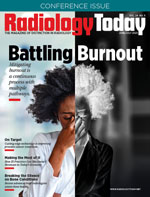 Dose Safety: New Horizons for Nuclear Medicine
Dose Safety: New Horizons for Nuclear Medicine
By Keith Loria
Radiology Today
Vol. 24 No. 5 P. 8
Nuclear medicine procedures help doctors diagnose diseases earlier to make treatment more effective without the cost and risks of surgery. These procedures are highly effective, safe, and painless tests that provide physicians with a detailed view of what’s going on inside a patient’s body.
But this isn’t anything new. Nuclear medicine has been in use for more than 60 years; however, it’s evolved considerably and can now be used to evaluate practically all systems within the body.
The field of nuclear medicine is expanding and growing at a remarkable rate. New, exciting radiopharmaceuticals are being approved nearly every year, providing new diagnostic capabilities for a variety of diseases.
Equipment is constantly advancing, providing better, higher resolution, and higher sensitivity images. Researchers at academic institutions and in the industry are finding new ways to improve in all these areas to generate better, more personalized scans that provide more information, more quickly and effectively. And, importantly, dose safety is improving.
SNMMI recommends that to prepare for a nuclear medicine test, patients should stay well hydrated and dress comfortably. Health care providers will provide any other instructions specific to the patient’s procedure.
“For nuclear medicine therapy, SNMMI-designated Radiopharmaceutical Therapy Centers of Excellence have demonstrated that they have the qualifications, experience, and performance criteria necessary to provide the highest level of care,” says a spokesperson for SNMMI.
The Practitioner Angle
Nuclear medicine practitioners use the smallest possible amount of radiopharmaceutical necessary to provide the appropriate diagnostic information. In fact, new research, more sensitive equipment, and even some AI products are allowing practitioners to reduce that amount even further, helping improve dose safety.
“To ensure the appropriate use of these procedures, virtually all nuclear medicine facilities have comprehensive quality control procedures in place as part of their accreditation,” the SNMMI spokesperson says. “Nuclear medicine physicians and their technologists are required to have up-to-date training through continuing medical education programs to maintain their accreditations and certifications.
New Trends
While there are many exciting new trends, nuclear medicine therapies and theranostics may be the biggest area of focus, according to SNMMI. Radiopharmaceutical therapy was first introduced in the 1940s but was limited in its use, primarily for thyroid disease. However, recently, there has been an explosion of new activity to treat a variety of cancer types. Some of these therapies are already being used clinically and many more are in development for many different types of cancer.
Theranostics is a combination of imaging and therapy in which the imaging provides information that enables new or more effective therapies. There are approved therapeutic applications for prostate cancer and neuroendocrine tumors. Dozens of other cancer-specific molecular targets are currently being tested in human clinical trials, promising to broaden the theranostics realm.
“There are many new and exciting things happening in these fields that we believe will transform many areas of medicine,” the SNMMI spokesperson says. “The doses used in nuclear medicine are already very safe; the benefits of any appropriately used and administered nuclear medicine procedure far outweigh the risks. Humans are exposed to radiation from nature on a daily basis, from the sun, from food and water, and from the Earth itself.”
Additionally, while some people worry about radiation because of what they have heard about the effects of nuclear accidents or weapons, which involved massive absorbed doses of radiation, SNMMI notes that those radiation exposures are thousands of times higher than diagnostic medical procedures, which use extremely low radiation doses under tightly controlled and thoroughly tested conditions.
Looking Ahead
Nuclear medicine and molecular imaging are growing so rapidly that it is becoming difficult to train enough scientists, physicians, and technologists to meet the growing demand; many new cancer-detection radiopharmaceuticals are on track for approval in the next several years.
“Imminently, we will likely see PET imaging as a primary diagnostic test to qualify patients for new Alzheimer’s disease therapies that are completing clinical trials,” the SNMMI spokesperson says. “On the therapy front, we anticipate positive results from several clinical trials over the next five years, resulting in a series of newly available radiopharmaceutical therapies to treat an expanding array of cancers.”
Additionally, SNMMI expects radiopharmaceutical therapy to become the poster child for personalized medicine, allowing practitioners to use nuclear imaging expertise to precisely inform the amount of activity to prescribe for a particular patient, to ensure the best possible treatment.
“Never has the future of nuclear medicine and molecular imaging held so much promise,” the spokesperson says. “The growth of targeted radionuclide therapy is particularly exciting and impactful.”
— Keith Loria is a freelance writer based in Oakton, Virginia. He is a frequent contributor to Radiology Today.
